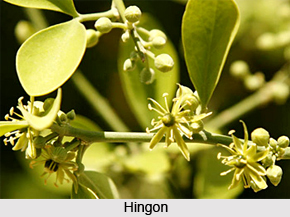 Hingon is a small evergreen tree or a spiny shrub which grows up to a height of about nine meters. It is found in the drier regions of peninsular India in various states including Karnataka, Tamil Nadu, Rajasthan, etc. The Botanical name of this plant is Balanites aegyptiaca (L.) delile. Some of the other names by which it is called in different Indian languages are Egorea, Hingoriyun, Hinger and Ingoriyo in Gujarati language, Ingalarade, Ingalara, Ingalukke and Inga-Lore in Kannada, Hingane, Hingan and Hingoli in Marathi, Angavriksha and Ingudi in Sanskrit, Gari, Gara, Ringri and Ingudi in Telugu, Hingan, Hingota, Hingoli and Hingu in Hindi language, Nanjunta in Malayalam, Ingudihala in Oriya, Nanjundan, Nanjunda and Totuvattu in Tamil and Hingot in Urdu.
Hingon is a small evergreen tree or a spiny shrub which grows up to a height of about nine meters. It is found in the drier regions of peninsular India in various states including Karnataka, Tamil Nadu, Rajasthan, etc. The Botanical name of this plant is Balanites aegyptiaca (L.) delile. Some of the other names by which it is called in different Indian languages are Egorea, Hingoriyun, Hinger and Ingoriyo in Gujarati language, Ingalarade, Ingalara, Ingalukke and Inga-Lore in Kannada, Hingane, Hingan and Hingoli in Marathi, Angavriksha and Ingudi in Sanskrit, Gari, Gara, Ringri and Ingudi in Telugu, Hingan, Hingota, Hingoli and Hingu in Hindi language, Nanjunta in Malayalam, Ingudihala in Oriya, Nanjundan, Nanjunda and Totuvattu in Tamil and Hingot in Urdu.
Hingon is a spiny shrub or small, evergreen tree, grows rarely up to 9 meters in height. The barks are grey in colour and young parts are pubescent, tomentose or glabrescent. The twigs are armed with stout, axillary spines about 1 to 6 centimetres long and often bear flowers or leaves. The leaves of this plant are alternate and two-foliate and the petioles are 3 to 6 millimetres long. The leaflets are elliptic or obovate and are 1 to 5 centimetres long, apex obtuse, subacute or broadly pointed and petioles are up to 0.5 centimetres long. The flowers of this Indian plant are small, greenish-white in colour, fragrant, borne in axillary, few or many-flowered fascicles. There are five sepals which are ovate and 3 millimetres long and outside is pubescent. There are five petals, oblong-obovate, and glabrous outside. Fruit is ovoid, woody drupe, about 2.5 to 6 centimetres long on a short, thick stalk, faintly 5-grooved, pale yellow in colour when ripe, enclosing a hard, fibrous seed embedded in an oily, offensive-smelling pulp. In central Indian forests, flowering in this plant takes place mainly in the months of April and May, and fruits mature in the month of November.
Hingon is native to north-eastern Africa and Arabia to the semi-arid and dry deciduous forest regions of the Indian subcontinent. It is found throughout the drier regions of peninsular India southwards to Karnataka state and Tamil Nadu, in western Rajasthan, and from south-eastern Punjab to West Bengal and Sikkim. This species grows well on black cotton soils in peninsular India and also common on open sandy plains.
The seed kernel oil of Hingon contains antibacterial and antifungal properties, and is reportedly used in treating skin diseases, scrapes and burns. The unripe fruits, seeds, leaves and bark are reported to bear anthelmintic and purgative properties. The fruit is regarded very useful for treating skin diseases and Whooping Cough or Dushta Kasa. The fruit pulp, mixed with goat`s milk, is rubbed on the chest to treat pneumonia in children. In northeastern Karnataka the powdered fruit, mixed with soap nut powder (from the fruits of Sapindus laurifolia: Sapindaceae), ginger, cardamom and clove, is used in treating jaundice. In this region the fruit extract is also regarded useful for treating jaundice when applied to the eye. Among the rural inhabitants of Bhavnagar District in Gujarat, the fruit pulp is used as an external application for acne and boils and among the Rabaris in the Barda Hills of Gujarat, it is given with curd (yoghurt) for diarrhoea. The seeds of Hingon possess expectorant properties, and are used to provide relief from colic and cough. The powdered seeds are used to ease childbirth. A decoction of the roots is emetic. An extract of the leaves and roots is used to wash inflamed areas of the body among the tribal inhabitants of Udaipur District in Rajasthan. The roots and fruits of this medicinal plant are believed to a potential source of diosgenin used in oral contraceptives. The bark is used as an anthelmintic in cattle and its juice is used as a fish poison. The acidic fruit juice is used to remove stains on clothes, and for cleaning silk and cotton, and the fruit pulp is regarded as an excellent corrosion inhibitor for brass.



















